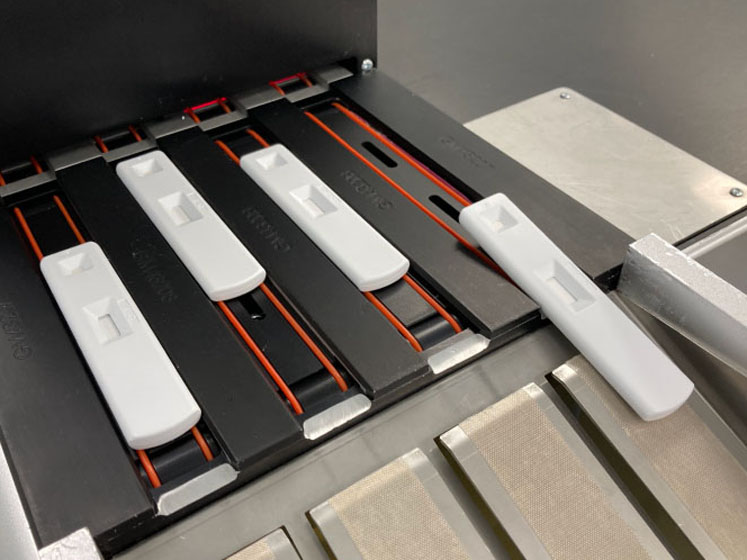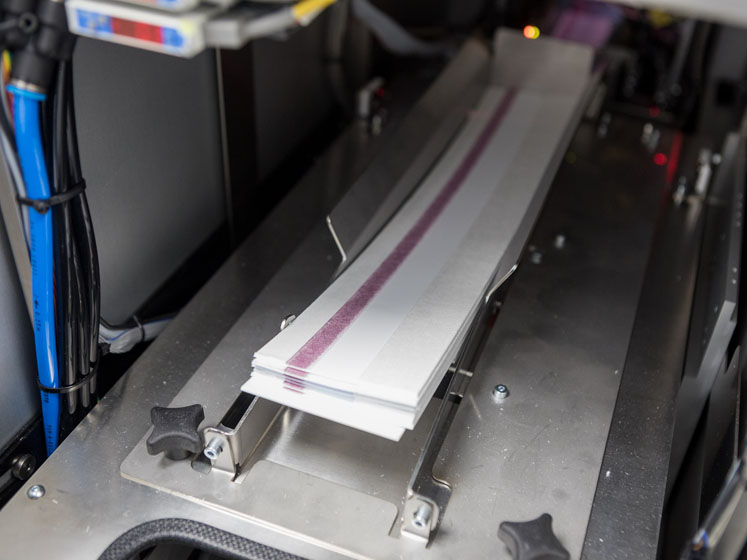Faced with this increasingly changeable world, companies are likely to prioritise averting risk and protecting their value through securing supply chains while trying to achieve their strategic growth goals.
Owing to the pandemic, lateral flow technology has been thrust into the mainstream — years before many industry leaders could have predicted.
This “newfound fame” means that the world has a greater awareness and understanding of this portable and rapid diagnostic technology.
By empowering patients with self-testing and fast results during the pandemic, this has set a precedent and a patient expectation to receive information on their health status quickly and efficiently.
We are at the start of a paradigm shift in testing from the lab to the home. Self-testing is forecast to be a major growth area within the global diagnostic market, with a recent Future Market Insights report suggesting that the global market for self-testing kits will be worth $11 billion by 2030.1

By 2026, the wider lateral flow market is projected to be worth $12.6 billion, with drivers being “the high prevalence of infectious diseases worldwide, rapid growth in the geriatric population, growing demand for point-of-care testing and the rising use of home-based lateral flow assay devices.”2
This is not restricted to human health, with food safety and veterinary lateral flow testing set to experience an uptick in use of the technology.
Meeting opportunities and overcoming challenges
This brings both opportunities and challenges for lateral flow test (LFT) developers both within and without human health. Businesses know that market entry with an LFT will be viable because the test will offer affordability, convenience, ease of use and quick results.
Most critically, many consumers are now familiar with using the LFT format. However, test owners need to be able to meet demand at the right quality and quantity; and, if they do not have the requisite in-house capabilities, experience and resources, this can be a huge challenge.
Taking a test from R&D and scaling it up into reliable, high-volume production requires the right expertise. Knowing the challenges and what to expect during different project phases takes experience.
It is essential to have a clear understanding of the later stages of development through to technical transfer and validation, and from scale-up to manufacturing, regulatory approval processes and commercialisation, to allow projects to be accurately planned.
Also, the complexity and burden of regulatory submissions should not be underestimated and should be considered at an early stage.
Owing to significant upfront fixed costs and ongoing operational costs when maintaining ISO- and GMP-compliant facilities, setting up and operating large-scale development and manufacturing facilities takes time to make a positive contribution to a business’s bottom line.
Resultantly, if new test owners decide to develop and manufacture in-house, end-user pricing, profitability and the speed of gaining market share may be negatively impacted.

This is especially true in growing and competitive markets such as the lateral flow industry, in which specific development and manufacturing expertise can be hard to come by.
This begs the question: how can innovative test developers ensure that their high-quality product reaches the market in a timely fashion while enabling stakeholders to benefit from them?
Larger, established lateral flow contract development and manufacturing organisations (CDMOs) such as Abingdon Health, who started operating long before the pandemic, have already been through the “growing pain” stage.
Their infrastructure and expertise are in place and their supply chains are layered with quality and contingencies.
Established CDMOs can offer fixed pricing through supplier bulk buying capabilities and can source key materials through mature supply chains, which allows for more favourable end-user pricing, budget planning and profitability for test owners.
Building a trusted, quality supply chain takes years to establish: many test owners just do not have the time or resources to match these capabilities.
Developing and manufacturing LFTs also come at significant financial and human resources, with considerable regulatory obligations to consider, such as the following:
- machinery must be maintained and periodically upgraded
- large inventories must be managed in line with demand
- staff must be managed through recruitment, training and development
- regulatory compliance can be resource-heavy and requires specialist expertise.
In regulated markets, there is an extra layer of complexity requiring niche expertise. CDMOs such as Abingdon Health, with in-house development, manufacturing and regulatory specialists, have a greater appeal to ambitious test innovators and growth-seeking companies.
Having access to these skills and experience offers a derisked and streamlined route to market.
The UK and EU medical device markets are going through regulatory changes with the introduction of UKCA (UK Conformity Assessed) marking and the transition of IVDD (In Vitro Medical Device Directive) to IVDR (In Vitro Diagnostic Medical Devices Regulation).
Working with a lateral flow CDMO with regulatory capability can make the process of launching a product quicker and more efficient. With products on the market, any significant changes to the item may require a new regulatory filing … and having that expertise available within your CDMO can reduce risk.
Outsourcing LFT development and manufacture relieves constraints, meaning that test owners can focus on other areas, such as developing new product concepts and marketing their existing ones, responding to shifting market dynamics, and training and developing staff.

Deloitte’s 2021 Global Shared Services and Outsourcing Survey Report looked at why businesses outsource their processes, including manufacturing.
It was found that “standardisation and efficiency of processes” and “cost reduction” were the two main reasons given, with 78% and 88% of participants listing these respectively.
Deloitte concluded that “when executed well, [outsourcing] can deliver competitive advantages by transforming the way organisations operate, making them more agile, efficient and effective.”3
Summary
The pandemic has instigated growth in the number of LFT companies, with new players joining to varying levels of success. But these young enterprises may not stand the test of time, even with highly innovative products, owing to the challenges faced in the development, manufacturing and regulatory process.
Why? Quite frankly, it takes skill and experience.
COVID-19 lateral flow testing broadened the awareness of self-testing across the world. Stretched healthcare systems and the growing number of people who want to take control of their health will only increase the demand for quick and affordable at-home testing for various non-COVID-19 indications.
This means that new tests detecting targets in a variety of sample types (such as blood and urine) will be required. The different processes needed to manufacture such LFTs — at scale — requires experience and know-how.
Creating a lateral flow manufacturing team and facility from scratch needs careful consideration. Is it worth the investment of time and money when an established developer and manufacturer can help to take tests from concept to commercialisation with less risk and in shorter timeframes?
The global medical device contract manufacturing market is projected to surpass $167.34 billion by 2030, at a CAGR of 10.9% (2021 to 2030), with the demand for affordable diagnostic solutions being one of the key drivers.4
Quality and reliability, no matter what ailment, condition or disease, will be essential.
Therefore, those CDMOs who have the right infrastructure, service provision and supply chains — and have an ability to overcome and pre-empt common lateral flow development and manufacturing issues — will be front and centre in meeting market demands.
Ambitious test innovators and growth-seeking companies have two options to meet their objectives: go it alone and build from within or use a CDMO as an extension of their team. In a growing and competitive marketplace, partnering with a contract manufacturer is likely to help test owners reach their market potential quicker and with fewer risks.
References
- www.futuremarketinsights.com/reports/self-testing-market.
- www.marketsandmarkets.com/Market-Reports/lateral-flow-assay-market-167205133.html.
- www2.deloitte.com/content/dam/Deloitte/us/Documents/process-and-operations/us-cons-global-outsourcing-survey.pdf.
- www.globenewswire.com/news-release/2022/01/11/2365020/0/en/Medical-Device-Contract-Manufacturing-Market-Size-to-Surpass-US-167-34-Bn-by-2030.html.




